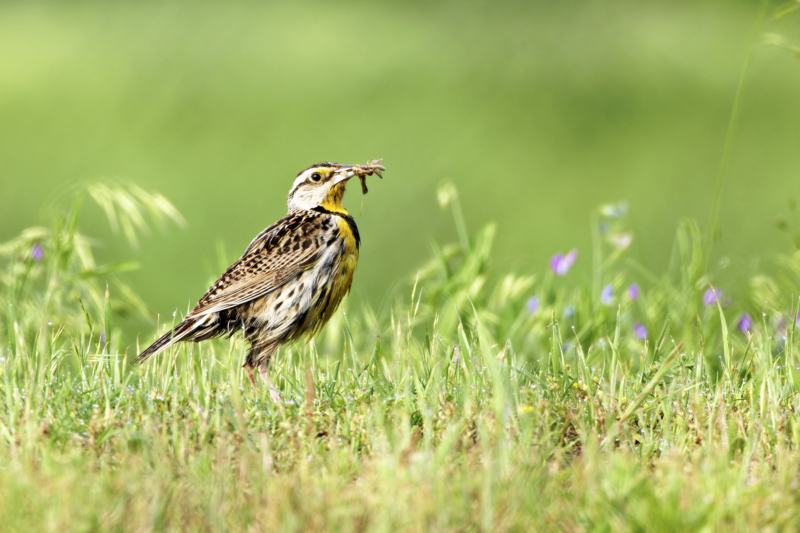Today’s photograph is of a Western Meadowlark that I photographed near the auto tour road at the Sequoyah National Wildlife Refuge in Oklahoma. This refuge sits in a transition zone where both meadowlark species occur, which makes careful identification important every time I spot one.

A few years ago, I learned firsthand just how easy it is to confuse the two species. Since then, I always double-check my IDs with experienced birders when needed. The Western and Eastern Meadowlarks look almost identical at a glance, but once you know what to look and listen for, their differences become clear.
Wildlife Notes: Western and Eastern Meadowlark Differences
The Western Meadowlark (Sturnella neglecta) and the Eastern Meadowlark (Sturnella magna) are closely related grassland birds found across much of North America. While they share the same bold yellow chest and black V-shaped bib, several traits reliably separate them.
1. Song Is the Best Identification Tool
Their songs are the most dependable way to tell them apart.
- Eastern Meadowlark song: A sharp, buzzy “dzert” or “bzeert” sound.
- Western Meadowlark song: A clear, rich, flute-like series of whistles that sounds more musical.
If you can hear the bird before you see it, the song alone often gives you the answer.
2. Face Markings (Malar Stripe)
This is the best visual field mark in good light.
- Eastern Meadowlark: Yellow malar (mustache) stripe.
- Western Meadowlark: White malar (mustache) stripe.
This single feature eliminates most identification confusion when visible.
3. Color Tone and Feather Edges
- Western Meadowlark: Paler overall, with more white edging on the wing and tail feathers.
- Eastern Meadowlark: Slightly darker and richer brown tones.
These details help confirm the ID when the malar stripe is harder to see.
4. Geographic Range
- Eastern Meadowlark: Primarily eastern and southeastern United States.
- Western Meadowlark: Central and western United States.
Oklahoma sits near the overlap zone, which is why both species appear at Sequoyah.
5. Hybridization Is Rare
Even where both species overlap, hybridization is uncommon. Mixed pairs usually occur only at the extreme edges of their ranges.
What Does “Dzert” Mean?
The term “dzert” refers to a single, sharp call note made by the Eastern Meadowlark. This call is:
- Innate, not learned
- Used as a territorial warning
- Often given when a person or another meadowlark approaches too closely
Unlike songs, which can vary slightly, this call stays consistent and is a strong ID clue.
Eastern Meadowlark Comparison Photo
Here is a photo I took of an Eastern Meadowlark in Arkansas, shown in breeding plumage. Notice the yellow malar stripe, which contrasts with the white one on the Western Meadowlark.

Photography Notes
Meadowlarks rely heavily on camouflage and often stay low in grass or short brush. I usually photograph them from the roadside or field edge to avoid pushing them deeper into cover. Early morning light works best for revealing feather detail and subtle color differences.
Their habit of perching briefly before dropping back into grass creates short shooting windows. I keep my shutter speed high and stay ready.
Image Information (First Image)
- Date: 12/03/23
- Time: 10:42 AM
- Camera: Canon EOS R7
- Lens: Canon RF 800mm F11
- ISO: 1250
- Aperture: f/11
- Shutter: 1/2000
- Exposure Compensation: 0
- Focal Length: 800mm
